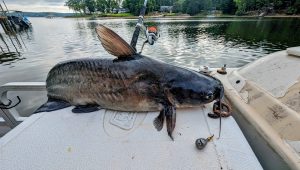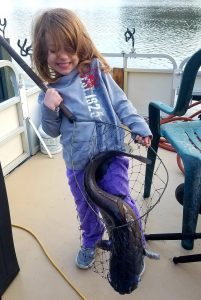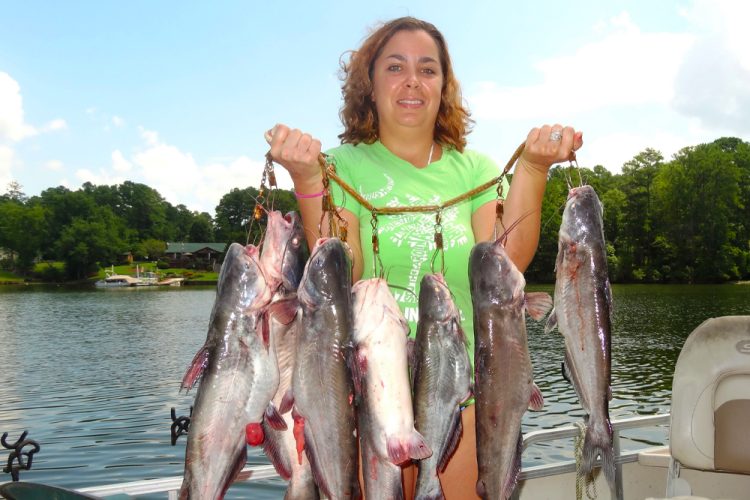Catching table-grade fish in hot weather can produce fun fishing and great eating.
Catfish for the Table
By Terry Madewell
Downsizing tackle and baits makes hooking more catfish likely and adds prime fillets for the table.
The powerful tail-thump of a heavyweight catfish on the end of the line is invigorating, but catfish don’t have to be big to be enjoyed. Catfishing is much more than just catching and releasing big fish, and the pursuit of Mr. Whiskers in table-grade size and big numbers is pure pleasure. Many waters have abundant catfish populations that can, and should, be enjoyed to the fullest. And “keeper-size” catfish offer opportunities to enjoy catfishing in multiple ways.
With the price of fish in the markets today so high, catfishermen can enjoy lots of fish-catching action while placing prime fillets on the table at reasonable costs. And if you’re reasonably adept with a fillet knife, the product will be much better than what you can purchase.
The process of catching catfish for the table is simple and fun. First, find them. Then, employ rigs that encourage eating-size catfish to bite. Finally, tempt them with baits that catch catfish by the numbers.
Pinpointing “Eaters”
Finding productive catfish spots is paramount to putting meat on the table. Catfish orient to diverse areas in lakes and rivers, and these features typically have two traits in common. First is a significant change in the bottom contour of the area. This can be a point, hump, ledge, channel junction or any feature that provides a deep-to-shallow-water travel route within a short distance.
The second is forage. When multiple catfish of any size gather in a specific area, odds are high it’s to eat. These ingredients are the keys to finding plenty of catfish. If you’re willing to move to find them in big numbers, the odds are you’ll catch plenty of catfish.
Another advantage is to fish when catfish are most likely to bite in big numbers, and during August, that’s the low-light feeding times. Dawn and dusk are prime times for fish to forage, and it’s more comfortable temperature-wise for fishermen.
Downsize for More Bites
The first tactic to put more fish in the cooler is to downsize your rigs and bait. I conducted my own multi-year survey years ago using 8-, 15-, and 25-pound test lines fished randomly around my boat. The results passed the common-sense test but were more dramatic than anticipated. The 8-pound-test line received twice as many bites as the 15-pound-test-line and three times the number of bites as the 25-pound-test line.

Fishing specific targets, including structure, snags, downed trees and stumpy ledges, plays a role in what size rig you ultimately select to use. While lighter line typically produces more bites, using adequate tackle to boat the fish is required to put it in the “take-home” box.
But using the minimum line size your fishing situation requires will improve your bite frequency.
It’s not simply the line that matters. The rod tip action should be reduced to encourage fish to take those smaller baits that are now paired with the smaller hooks and lighter sinkers you’ll be using.
This sets up a scenario where odds are high that if you employ several rigs, a characteristic of most catfisherman, you’ll often have multiple fish hooked. So, you could use help to fight fish.
An advantage to using lighter tackle is that it opens the window to introduce youngsters, or adults, to the sport while helping you fill your box with catfish. Anglers new to catfishing want to catch fish, lots of fish, and enjoying fast-paced fishing success is the ideal time to build a bond with new anglers. The lighter tackle not only entices more hookups, it also increases the fish-fighting-fun aspect of catfishing.
High end tackle is fine, but not necessary, for this type of catfishing. Light spinning or spin-cast rigs get the job done.
Use Baits Catfish Can’t Resist
Live bait options are abundant and are incredibly attractive to catfish. Nightcrawlers or small minnows attract and catch channel, blue, flathead and bullhead catfish.
Don’t limit your selection to store bought worms. Dig your own redworms or nightcrawlers, or find seasonally available specialties such as catalpa worms, when and where available.
Another long-time favorite that’s wildly productive is stinkbaits. Granted, not everyone wants to mess with the stinky goo, but the right stinkbait will change your catfishing life for the better.

I’ve been blessed with nine granddaughters, and when they fished with Papaw during their formative fishing years, I always had some Doc’s Catfish Getter Dip Bait aboard with several rods rigged for fishing stinkbaits. My ideal day was to experience action so fast that I did nothing but bait rigs with the smelly goo, net fish and drop them in the cooler, re-bait and cast rigs again.
Typically, by then, another rig was loaded with a catfish, and I’d repeat the process. Certainly, other stinkbaits produce similar action.
Channel catfish are found throughout the country, but stinkbaits don’t simply target channel cattish. On lakes with a blue catfish population, in multiple states where I’ve fished with stinkbaits, I’ve found that smaller blue catfish make up nearly half the catch on most days. And occasionally we’d hook a bigger blue that tested the mettle of both rig and angler, catapulting the excitement to another level.
Small chunks of cut-bait are also powerful catfish attractants. Cutting small chunks of fish species found in the water you fish produces prime baits. Thumb-sized chunks of gizzard or threadfin shad are lethal. Check regulations where you fish, but where legal, small chunks of bream and panfish work well. The documented success of chicken livers and chicken breast is accurate, and both produce excellent results.
With plenty of bait options available, I mix and match my catfish offerings and usually discover a bait that performs best on a specific trip. Don’t get locked into a single bait because you’ll likely discover on the next trip catfish may favor something else. But the key is simply to use whatever is required to fill the box on a given trip.
We all take the sport of catfishing seriously, but we never have to leave the fun out of the process. The focus can be intense and serious when appropriate. But catfishing for the table generates intense interest with fun fishing to combine for an ideal intensely fun combination that puts meat on the table.
(Terry Madewell of Ridgeway, S.C. has been an outdoor communicator for more than 45 years. He holds a degree in Wildlife and Fisheries Management and has a long career as a professional wildlife biologist/natural resources manager. He’s passionate about sharing outdoor adventures with others.)



